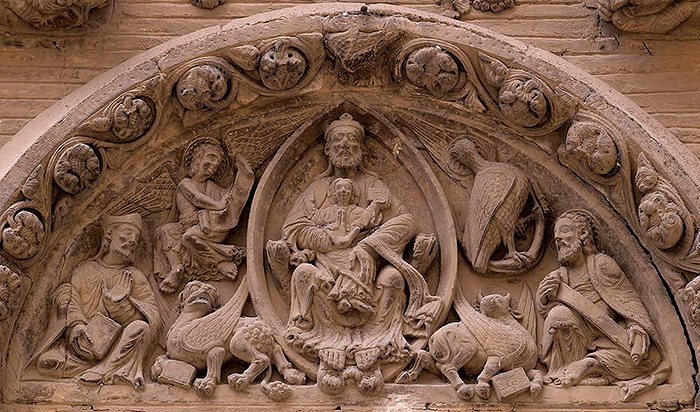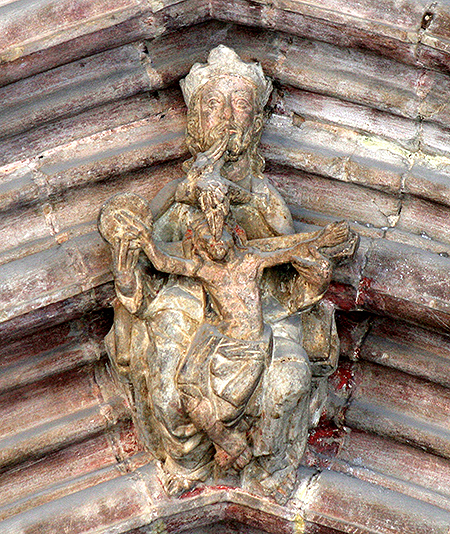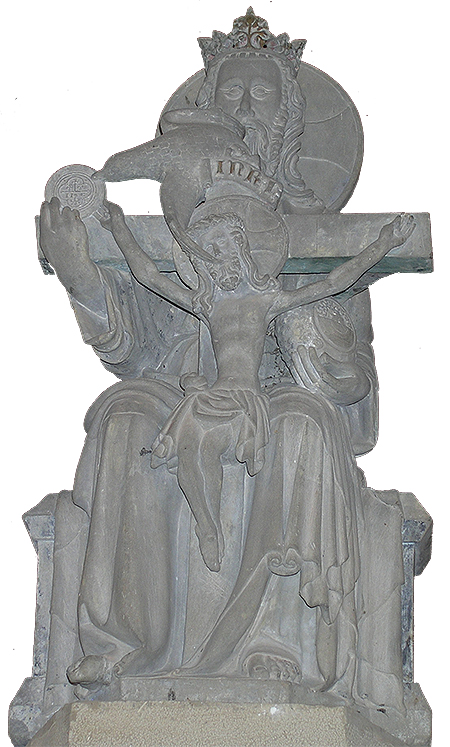21 May
lecture series
LESSER-KNOWN IMAGES OF NAVARRESE MEDIEVAL ART
The mystery of mysteries: the image of the Holy Trinity in medieval Navarre
Ms. Clara Fernández-Ladreda Aguadé
University of Navarra
The appearance of the Trinity in Christian art is late. In fact, until the ninth century there is no known image of the Trinity properly speaking, although it will only be from the eleventh century when they begin to proliferate, culminating the process in the twelfth century, when the three main groups of the Trinity: Throne of Grace, Psalter and Triandric are constituted or have just been constituted.
Navarre is one of the richest Hispanic territories in medieval representations of the Trinity, both in quantity and variety, as we have examples of almost all the known variants: Paternity, Throne of Grace, Psalter, Triandric and Trifacial.
Of the first, the Trinity Paternity, we have a sample: the tympanum of San Nicolás de Tudela. This iconography is constituted by the figure of the seated Father, who holds in his bosom a figure of Christ "child", accompanied by the dove of the Holy Spirit, whose position can vary, but that in Tudela is located on the head of God the Father. Although it is one of the oldest iconographies, since it makes its appearance at the end of the X century, it had very little success, so that for the whole of the average Age there are only about twenty cases. That is why it is striking the diffusion it had in Spain, where in addition to the Tudelan one there are four other examples, all of them late Romanesque and all of them in monumental sculpture, which constitutes a unicum: capital of the mullion of the central portal of the Portico de la Gloria in Santiago, relief of the NW pillar of the cloister of Silos, pillar of the chevet of the cathedral of Santo Domingo de la Calzada and tympanum of Santo Domingo de Soria. An attempt has been made to explain this status and the fact that they were used in such key and public points as the doorways by the peculiar historical circumstances of Spain: we would be facing an attempt by Spanish Christians to reaffirm the Trinitarian dogma and insist on the divine nature of Christ, in the face of Jews and Muslims, to whom both features were especially shocking and which were so abundant in our country, and more specifically in Tudela.

Plate 1. Holy Trinity. Paternity
Church of San Nicolás (Tudela)
The Throne of Grace is represented by four works: the mural of the Tree of Jesse in the cloister of the cathedral of Pamplona -today in the Museum of Navarre-, the façade of the church of San Saturnino in Pamplona, the titular statue of the Shrine of Our Lady of Fair Love of Erga in Aguinaga -today in the church of this town- and a panel in times in the Huarte collection of Pamplona -of unknown provenance, but certainly Navarre-, all from the XIV century, except the panel in the Huarte collection which is from the first half of the XV century. As is typical of this iconography, they are composed of a seated figure of God the Father, holding the Crucifix between his legs, plus the dove of the Holy Spirit, whose position is very variable. The Throne of Grace makes its appearance in the first decades of the XII century and will have a great success, in such a way that between the XIII and XVI centuries it will be the most frequent iconography of the Trinity. The Navarrese examples have some very curious and significant peculiarities, which have gone totally unnoticed or have been misinterpreted, such as the circle held by the three Persons, which must be interpreted as a Sacred Form -in Aguinaga totally explicit-, or the sophisticated attribute that the Father carries in Aguinaga, which is not, as has been said, a mere ball of the world but a synthetic representation of the Creation, with the separation of the three elements: stars, earth and water.

Plate 2. Holy Trinity. Throne of Grace
Parish Church of San Cernin. Pamplona

Plate 3. Holy Trinity. Tone of Grace
Shrine of Our Lady of Fair Love of the Trinity of Erga. Aguinaga
Of the Psalter Trinity, which emerged at the end of the 11th century and is usually linked to the psalmistic context -biblical psalms, psalteries, commentaries on the psalms-, we have one case, a miniature from the Breviarium Pampilonense, dated 1332. It fits perfectly into the guidelines of this iconographic variant with the first two divine persons in anthropomorphic form seated on the same throne, and accompanied by the dove of the Holy Spirit, placed between the two on high.
There are two examples of the triandric Trinity: the tomb of Chancellor Villaespesa in the cathedral of Tudela from ca. 1420-25 and the funerary relief of Enequo Pinel in the parish church of San Pedro de Olite dated 1432. This iconography makes its appearance in the XII century in a punctual way, acquiring a boom from the XIV century. sample to the three people in human form, arranged side by side, initially frontal and equal, although with the passage of time the frontality is attenuated and they begin to relate and form a closely united group , and begin to differentiate themselves by attributes and ages. In addition, at the beginning they are sedentary and at the end of the Age average the upright modality is introduced, being precisely to this one to which the Navarrese works belong.
Finally, in Navarre we have six Trinidades Trifaces or Trifrontes, a variant composed of a trunk, with a head and three faces. Most of them are Romanesque, like the capital and the bracket of Artaiz, and the capitals of Garitoain and Iriso, although some are already Gothic like the tympanum of the church of the Trinity of Tudela perhaps from the XIV -disappeared and known by a drawing- and the table of the Trinity of Tulebras dated 1565-1570. It is an iconography that appeared in the XII century, although its diffusion seems to be late medieval. In any case, both this variant and the Tricephalous Trinities were early condemned by the Church.
